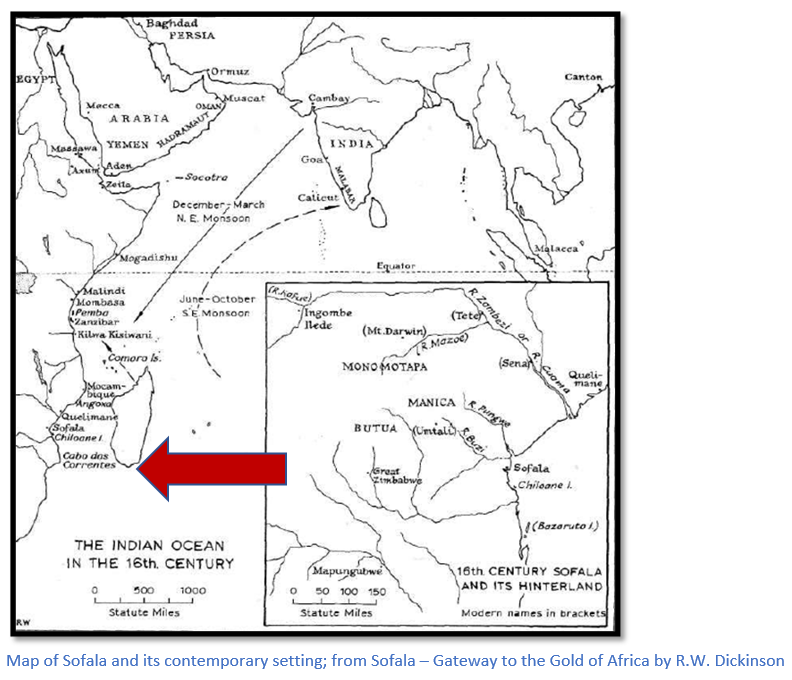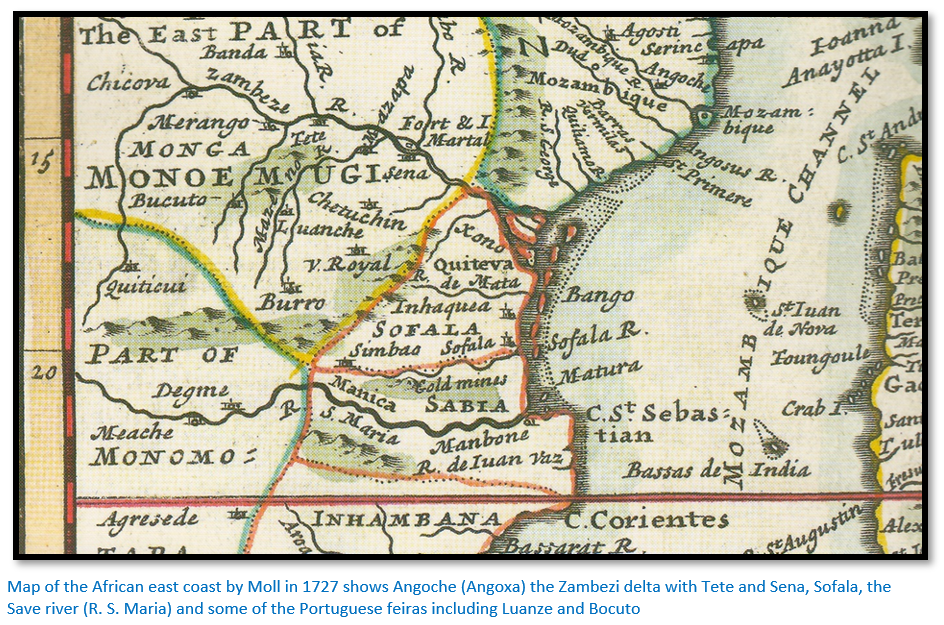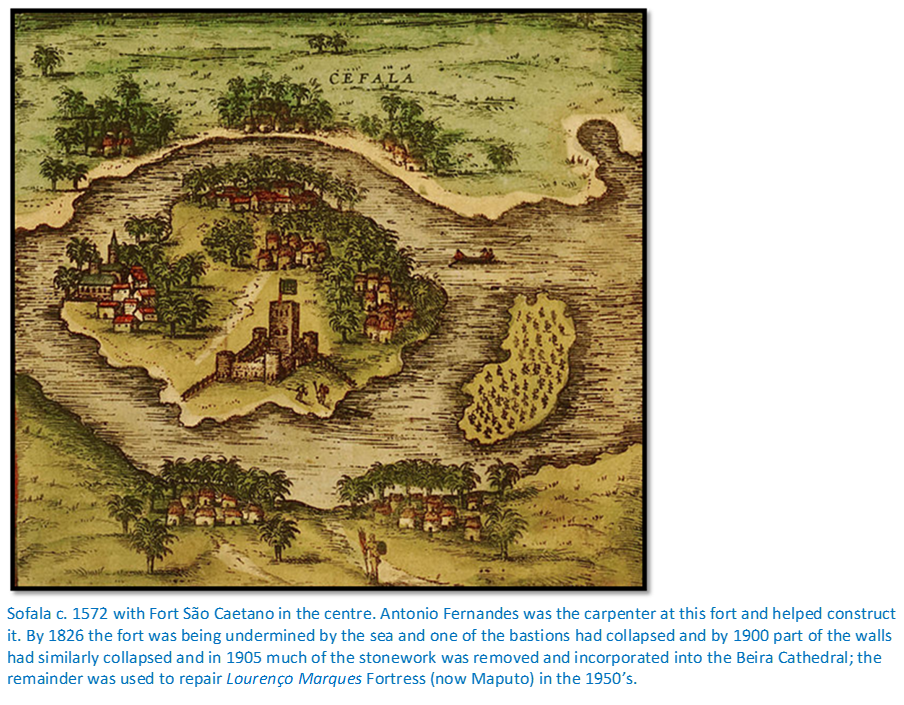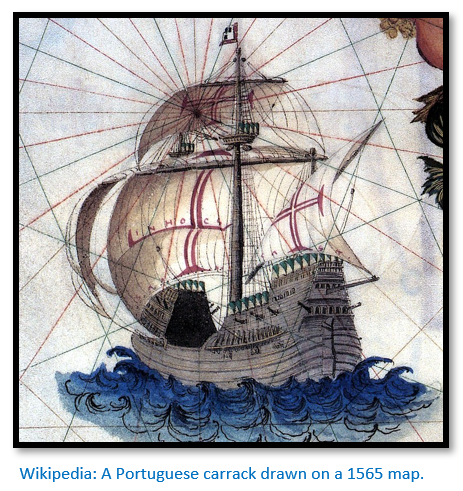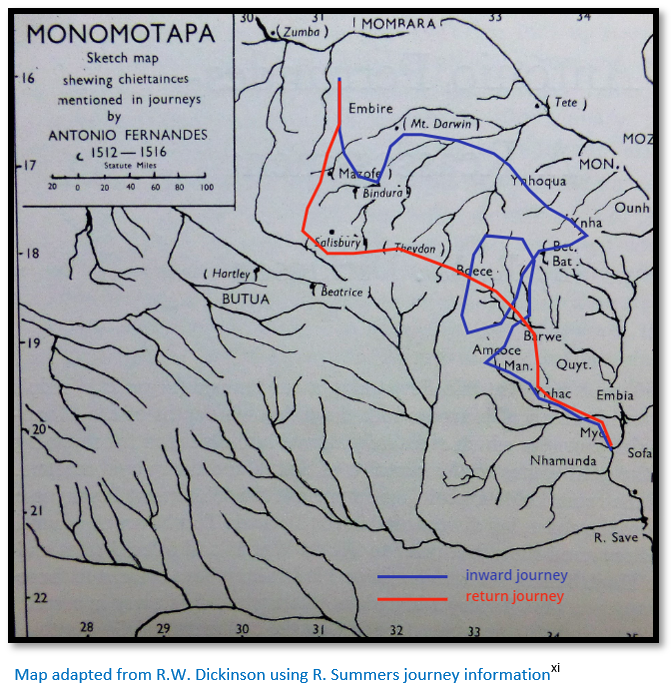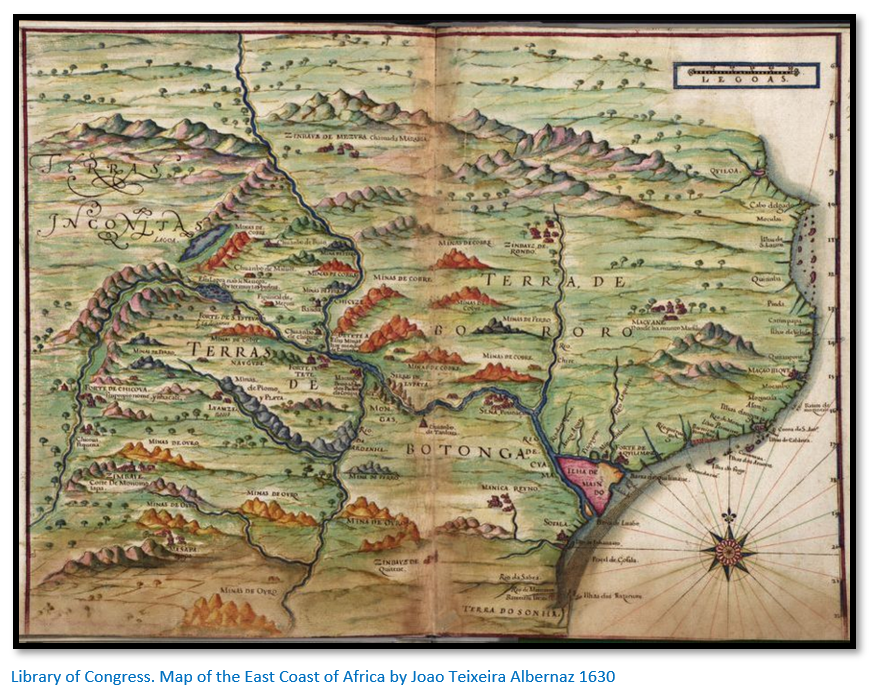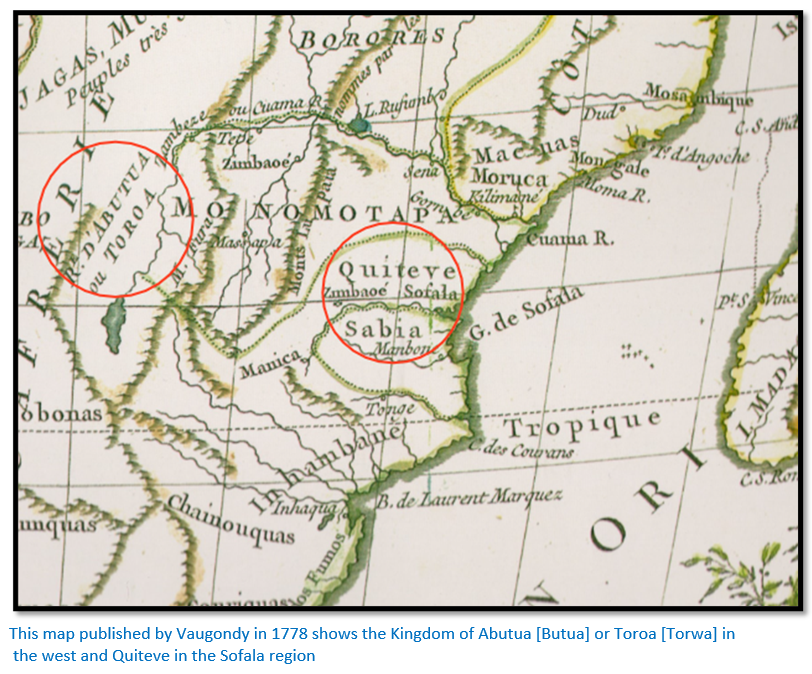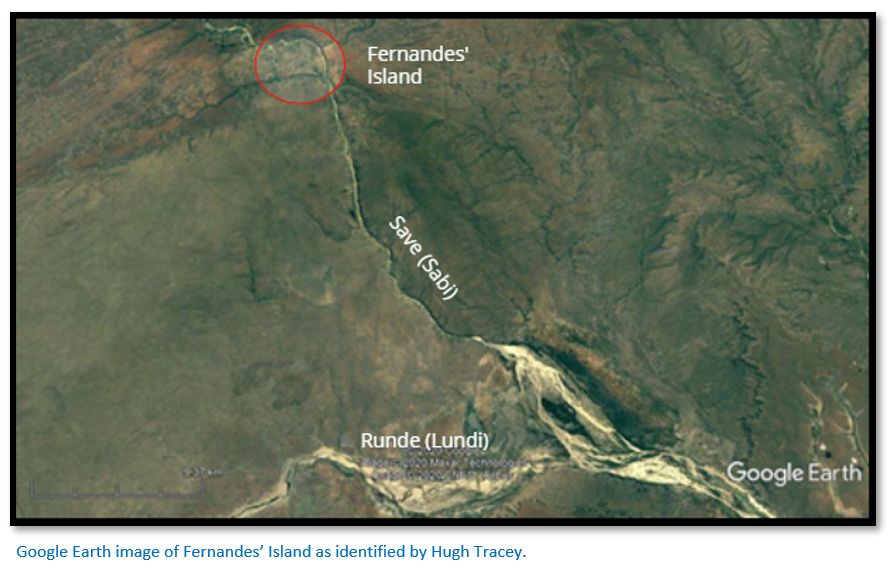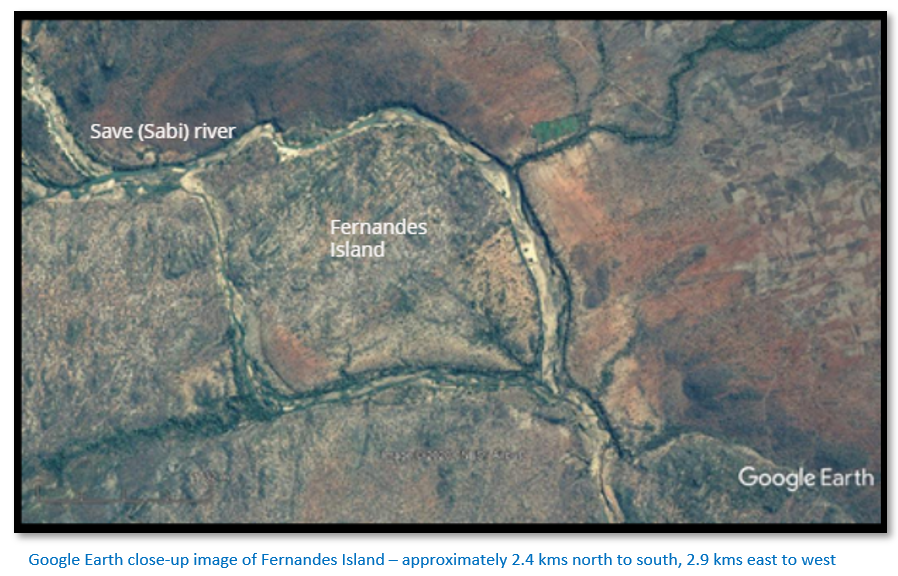Home >
Mashonaland Central >
Antonio Fernandes, probably the first European traveller to Zimbabwe in 1511 - 12
Antonio Fernandes, probably the first European traveller to Zimbabwe in 1511 - 12
His life as we know it is summed up by Hugh Tracey in his Rhodesiana article: “Brought to Sofala as a degredado [a degredado was a criminal, but we don’t know what offence he committed] in 1505, working on the construction of the fort of Fort Sao Caetano as a carpenter and as a member of the garrison. Mentioned again as a degredado in 1510 but chosen shortly afterwards perhaps on account of his grasp of the Karanga language[i] to take the risk of the exploration of the interior, a dangerous task to which degredado's were usually assigned. The great success of his Monomotapa journeys, his popularity with the Africans and the mass of valuable detail he acquired may have earned for him a reprieve, for not only was he given further responsible duties, but he is never again referred to except as ‘carpenter and interpreter.’ It would appear that he never learned to read and write for, apart from his association with the clerk Gasper Veloso, in subsequent entries his name is coupled with another man on three occasions in these words: ‘Antoneo Fernandes, the carpenter of this fortress, with Goncalo Diaz, his clerk.”[ii]
Background to Portuguese exploration in present-day Zimbabwe
Broadly Portuguese exploration of the region falls into two phases:
(1)1498 – 1531. This period included a reconnaissance of the coast with increasing detail being added to the charts by the caravel masters. In 1505 ships captained by Pêro d’Anaia arrived at Sofala which until then had been a Swahili Muslim trading post with the express aim of establishing a secure foothold, the first fortification built by Portugal, on the coast of East Africa. Named Forte de São Caetano de Sofala its function was to monopolize the gold traffic coming from the interior, from the Mutapa, then Monomotapa State, whose gold trade was then in the hands of Muslims, described by D. Manuel I as: “the richest mines of any part of those parts.” In 1506 the Mutapa sent envoys to Sofala with presents and this raised Portuguese hopes that they could build a trading relationship with the Mutapa State. It is within this period that Antonio Fernandes made his journeys into the interior from Sofala.
(2)1531 onwards. In this period which starts with the year that Sena was established as a Portuguese outpost a more systematic penetration of the interior was made by the Portuguese using the Zambezi (Cuama) and its tributaries onto the northern plateau of Mashonaland and acquiring progressively more information on the interior and the source of the all-important gold and ivory.
The Portuguese reports refer to a number of individuals named Antonio Fernandes
Hugh Tracey notes that the name Antonio Fernandes in various spellings appears thirteen times in the Portuguese records between 1505 and 1514.[iii]
1 | Antonio Fernandes | Carpenter at Sofala fortress | 1506 |
2 | Antonio Fernandez | Clerk of the Kilwa factory | 1506 |
3 | Antonio Fernandes | Keeper of the Kilwa stores | 1507 |
4 | Antonyo Fernandes | Clerk of galley Santa Maria da Ajuda at Cochin | 1509 |
5 | Antonio Fernandes | Blacksmith at Arzila | 1509 |
6 | Amtonyo Fernandes | Collector of alms at Kilwa | 1509 |
7 | Antonio Fernandes | Degredado at Sofala fortress | 1510 |
8 | Antonio Fernandes | Stewart of the ship Bonaventura at Canannore | 1510 |
9 | Antonio Fernandez | Unidentified at Cochin | 1510 |
10 | Antonio Fernandes | Unidentified at Sofala | 1511 |
11 | Antonio Fernandes | Resident at Goa | 1514 |
12 | Antonio Fernandes | Knight at Goa | 1514 |
13 | Antonio Fernandez | Esquire of the Portuguese King's household | 1514 |
Tracey thought the first and seventh references to Antonio Fernandes were those most likely to be relevant.
The eleventh reference to Antonio Fernandes in the list above “Resident at Goa” may also be the same person. Described as a married man at Goa who was given a grant by the Captain-general and Governor of the Indies, Afonso d’Alboquerque: “in the name of the King our Lord because he discovered for me certain things in the service of the King.” Tracey thought he might have been sent across the Indian Ocean to Goa to report in person to the Governor on his discoveries in the Mutapa State [Mwene Mutapa or Monomotapa “ravager of the lands” in Shona] and received his recognition in the form of a grant.
In October 1514 Afonso d’Alboquerque writes in a letter: “The officials of Sofala write to me that they have news of the man whom they sent to discover the city of Benomotapa, whence the gold comes from, that on the way he fell ill and was entertained by the Moors. I think that they will have given your Highness a full account of the matter from that place.”[iv]
Whoever he was, Antonio Fernandes must have had a good ear for African languages and an ability to build good relationships with the chiefs he met on his journeys.
Why was exploration of the interior important?
When the Portuguese first arrived at Sofala in 1505 they expected rich pickings. The first clerk of Sofala fortress, Diogo de Alcacova in 1506 reported that at its’ peak over a million meticais[v] of gold per year was traded by the Swahili traders at Sofala annually.[vi] But their hopes were quickly dashed as the trading results in 1506 showed just 8,176 meticais of gold and much of it came from Portuguese raids on the Swahili trading posts. For the period 1506 to 1518 in the five years for which records survive, a total of only 54,887 meticais of gold are recorded.
Within the first two years of establishing Sofala the Portuguese realised that the gold trade had shifted north, and the Swahili traders were now exporting their gold and ivory down the Cuama (Zambezi) river and using Angoche as their trading post and not the Sofala trade routes. Often however their reports stated that tribal wars were interrupting the trade. They needed to explore and gather information on the gold trade of the interior themselves and break free of relying on the few Swahili traders at Sofala. António de Saldanha during his three year term from 1509 to 1512 as captain-major of Sofala and Mozambique Island began to use the degredado’s at Sofala fortress as explorers.
The Portuguese needed to know where the gold was sourced, who controlled its collection and trade, to establish where the King of Mutapa State lived, the routes used for transporting gold and ivory to the coast, if food supplies were available and the goods that were used for its purchase. Antonio Fernandes journeys provided the names of the Chiefs and those contacts that the Portuguese needed in order to take over the gold trade from the Swahili traders.
Corrections to Hugh Tracey’s accounts
Subsequent historians (Dickinson, Godlonton, Schofield, Montez and Lobato) have revised Tracey’s interpretations as new information has come to light. For instance, Tracey assumed Gaspar Veloso’s account described two journeys made in 1514-15. Lobato identifies three journeys – the two described by Veloso, where the mention of Kilwa closing, suggests Fernandes’ journeys took place in 1511 and 1512 and a third journey with details of the Zambesi river in 1513-14 reported by the then Captain of Sofala, Joao Vaz d’Almada in 1516.
Tracey relied on maps showing the Angoche river south of Sofala; Dickenson states the evidence points to it being north of Sofala.[vii] Chief Inhamunda [Inyamunda] ruled south of Sofala, not in the north impeding passage to Manicaland.
Many historians have said it was unwise of Tracey to try and trace Antonio Fernandes’ journey by place-names as places were often named after living Chiefs. Reconstructing a route using place-names is extremely difficult as it is not possible to identify with any certainty four hundred years later the places to which Fernando refers.
Tracey also attempted to compute Fernandes progress over various section of the journey: “This route would make the 24 days’ journey to Manyika at Penhalonga about 326 miles at a reasonable average of 14 miles a day along the footpaths through the veld.”[viii] Dickinson felt that the winding footpaths and the lengthy halts with the Chiefs along the way who all demanded gifts and explanations from Fernandes made these mileage calculations extremely doubtful.[ix]
The major difference between the Tracey and Dickinson interpretations of Fernandes’ journeys is that Tracey believes that he travelled from the Save river around the southern slopes of the Chimanimani mountains, whereas Dickenson believes he took the direct route up the Buzi river to the Manica gold fair.
Having initially written an account using Tracey’s version of events, I have now removed it believing it would not have been possible for Fernandes to travel around the southern slopes of the Chimanimani mountains and then include the Manica mountains and northern plateau of Mashonaland, Hartley goldfield, Mhangura and Chinhoyi with their copper deposits, Mazowe and Enterprise goldfields in his first journey in just four months. On his second journey Tracey believed Fernandes covered much of the same ground but went as far as Kwekwe and the Gweru / Shurugwi goldfields. Both journeys as described by Tracey seem questionable.
Antonio Fernandes’ journeys into the interior
His journeys into the interior of the Mutapa State, now within Zimbabwe were carried out in 1511 – 12 [Tracey states 1514 – 1515] with his reports dictated to the clerk Gaspar Veloso in early 1516. The then Captain of Sofala, Joao Vaz da Almada, wrote to the King of Portugal, Manuel I at this time and refers to Antonio Fernandes with “affection and pride” and states he was a carpenter and builder with Pero d’Anaia, the first Captain of the Portuguese Fort Sao Caetano in Sofala in 1505 and thus the first colonial Governor of Portuguese East Africa, now Mozambique.[x]
Almada wrote that Fernandes had “already been to Benomotapa” where he was held in great esteem and had acted as a peace-maker between rival inland tribes and was shortly to be given further responsibilities. Furthermore, he agreed with Fernandes’ suggestions for disrupting and taking control of the inland gold trading network away from the Swahili traders writing: “In a notebook I am sending there to your Highness of the things this Antonio Fernandez saw, you will see how things here can be righted.”
Antonio Fernandes accounts of his two journeys were written up at Sofala (Fernandes’ was illiterate) by the clerk Gaspar Veloso and are today kept in the National Archives of Lisbon, Portugal and were probably sent in July 1514 to the Captain-general and Governor of the Indies, Afonso d’Alboquerque.
The Portuguese carracks called at Sofala in the months July to September before catching the favourable trade winds across to India – a sea journey which took about two months.
For those that don’t wish to trawl through the sixteenth century report by Gaspar Veloso there is a map of Antonio Fernandes’ travels below superimposed onto a map adapted from R.W. Dickinson in which he marks the names of the Chiefs’ referred to in Veloso’s report.
The reports translated by Eric Axelson and Sr. Freire de Andrade.
For many years the reports lay disregarded in the Torre de Tombo archives[xii] until they were first translated by Eric Axelson in 1939, with a later translation prepared by Sr. Freire de Andrade.[xiii] Although the translations are similar there are interpretation differences. For example, Axelson translated Veloso’s vem ter in relation to the river systems as “came to meet” meaning two rivers joined or flowed form the same source, whereas Andrade prefers “run to” as the evidence indicates that Fernandes was trying to indicate that having followed up one river valley you “came towards” the next river system once the watershed was crossed. For example, in general the Buzi river which runs from just north of Sofala [Angoxe][xiv] towards the northern edge of the Sabi Valley and the Save (Sabi) / Runde (Lundi) [Quitengue] river runs up towards the watershed of the Zambezi [Cuama] river.
The Gaspar Veloso report of the 1511-12 journeys to the King of Portugal
They were written by Gaspar Veloso, the clerk at Sofala and addressed to the Manuel I, King of Portugal. They are brief outlines of Fernandes’ journeys describing where he had been and what he found, and they were not signed by him as he was illiterate. Here is Eric Axelson’s translation of the document:[xv]
These are the Kings that there are from Sofala up to the mine of Monomotapa and the things that there are in each of these kingdoms.
1. The first King who borders on Sofala is called Mycamdira and there is nothing in his land except victual’s and ivory.
2. Another King, who is beyond this latter, is called the King of Mazira and he has nothing except victuals, and he is two days journey from the other written above.
3. The King of Quytomgue is from this latter a journey of three days and he has nothing except victuals.
4.The King of Embya is from this latter a journey of four days and he has nothing there except banditry.
5.The King of Ynhacoucee is from this latter another journey of three days; he has victuals and ivory.
6.The King of Ynhacoucee is from this latter another journey of five days. He is captain-in-chief of the King of Monomotapa. He has a great land. Fairs are held in his land on Mondays and they are called the fairs of ‘ssembaza’ there the Moors sell all their merchandise. There flock also the Kaffirs of all the lands. And he also has many victuals. That fair is said to be as big as you can see anywhere. And there is no other money than gold by weight.
7.The King of Manhiqua is from this latter a journey of six days. He has much gold here.
8.The King of Amcoce is from this latter a journey of four days. And he extracts much gold in all his land. And this man saw it being extracted and says that where the gold is, is known by a grass which is like clover, which grows over it. He says that the chief part is in bars as large as a finger and in bulky grains. And he (the King) has nothing else except his gold. And whoever extracts this gold pays half to the King. And all victuals come to him from outside.
9.The King of Barue is from this latter another journey of four days. And he has gold which comes to him from outside. And there is much ivory in the land.
10.The King of Betomgua is from this latter a journey of three days. And he has no gold except some which comes to him from outside.
11.The King of Inhaperapara is from this latter another journey of four days. And he extracts gold from all his land. And he is a great King.
12.The King of Boece is from this latter another journey of five days. And he has gold which comes from outside. And he is a great King.
13.The King of Mazofe is from this last a journey of four days. And there is much gold in this land. And half which is extracted is paid to him.
14.From there he went to Embire [Mbire] which is a fortress of the King of Monomotapa, which he is now making of stone without mortar, which is called Camanhaya and where he always is. It is a journey of five days. And from there onwards they enter into the Kingdom of Monomotapa which is the source of the gold of all this land. And the latter is the chief King of all these. And all obey him from Monomotapa to Sofala.
15.Beyond the latter is another King who does not obey him, who is called the King of Butua. And from him (King of Monomotapa) to the latter (King of Butua) is a journey of ten days. He has much gold. This is extracted alongside the rivers of fresh water. And he is as great a King as the King of Monomotapa. And he is always at war with him.
16.The King of Mobara is from Monomotapa a journey of seven days. In this land there is much gold and much copper. And from there they bring the copper to sell it to Monomotapa in ingots like ours and also through all the other land. These men are badly proportioned and are not very black; and they have tails like a sheep. There lies a great river between this King and the King of Monomotapa, which they cross in canoes when they bring their merchandise to sell. And they place it on land and return to the other side. And then come the Moors or the kaffirs and take the merchandise if they are satisfied with it and they leave there the clothes and any other merchandise that they carry; and then come those with tails; and if they are content with the merchandise that has been left, they carry it with them; and if they are not content, they go away and leave it; and they do not return until more has been placed down, or they are brought back by signs. And these people of the tails worship cows. And if any of them dies, they eat him and bury a cow. And when a negro is darker, they pay more money for him, to eat him. And they say that the flesh of white men is salter than that of black.
17.The King of Ynhoqua [Nyakwa] is at war with the King of Monomotapa. And it is a kingdom of much gold. And it is from Monomotapa a journey of five days. And onwards from this kingdom this man did not pass owing chiefly to the wars which they were between these Kings: and also, because he did not have presents to give these Kings, as it Is customary in all the land for strangers to do on arrival for the sake of their security; and if they should want to talk to him, they should give him something; and if they do not give it, they cannot speak to him. And the Kings give always double in satisfaction. And from there he turned and came to the Kingdom of Mozabia on his Sofalan journey. This was not the way he had gone; the only reason was for him to see other lands. In this kingdom are cloths of cotton which go to be sold in Monomotapa.
18.From Ynhoqua he came to the kingdom of Moziba on his Sofalan journey. In this land there is nothing except cloths of cotton that are made in it and they carry them to sell in Monomotapa.
19.From there he came to the kingdom of Quytegue which is seven days from this latter. In this land there is much gold; the gold is extracted in the land. It borders on Batogua in which there is much gold and ivory. This gold is extracted in the same territory and it is very much. And this way has a river which comes to meet the Cuama and goes out into the sea sixteen leagues from the bar of Sofala. And in this same river of the land of Quytegue could be built a factory house on an island which is situated in the middle of the river, it would be about a day's journey by horse in length and as much again in width. And if this house were built your Highness would have the gold of all this land and also that of Monomotapa; for the latter is a journey of ten days from the island. And beyond this that has been said, it would be possible to trade much ivory to carry to India or to these kingdoms. And moreover, the trade of Sofala would be revived, which at present is ruined by a smaller river that comes from Angoxa towards this river of Quytegue whence come many zambucos laden with cloths, which they trade throughout the land. And if your Highness made this house, it would be possible for a brigantine to cruise about, which would guard these rivers, so that there should pass no merchandise from Angoxa or from any other part; for the Moors of all this coast labour as much as they can to damage this trade of your Highness, for it seems to them that if they can ruin it, your Highness will order the fortress of Sofala to be disbanded. And they have great hope of this because Kilwa is being disbanded and because of the factory that is now being erected at Malindi; since they know moreover of the disbandment of Angediva and of Socotra, it seems to them that your Highness is going to order Sofala to be disbanded. And if this house were securely established, your Highness would have the trade of Sofala and you would have all the gold of this land of Quytegue and also of Monomotapa, for it is very close. And all these things Antonio Fernandes has had in secret; he has told them to nobody here save to me to tell your Highness. And because he returns to Monomotapa and runs the risk of dying owing to the many wars that there are in the land, I asked him to tell me anything that would be to your service, so that I could report it to your Highness. And he has always told me that he wants very much to go to Portugal to tell your Highness of things of your service.
20.From there he crossed through the land of Betomgua and came to the land of Baro, where there is also gold. And from this Baro to Betomgua is five days’ journey. And from there he came to Sofala in twenty days. He brought with him from the first journey kaffirs who had dared to come with him despite the fear which the Moors inspire in them of us; they brought for trade 900 meticais which they traded in the factory; and they brought as a present to the captain 100 meticais. And the second time he returned he brought kaffirs that came to trade, and they brought a present to the captain. He took on the journey the first time, in going and returning, four months. And the second time he took longer because of the wars and floods. And these people do not believe in anything, except the new moon, because the first day that it comes, they worship. They are people that are not very black though they have their hair like those of Guinea: and those of the tails who worship cows and eat men are shorter than these. And these people meeting those of the tails go about armed with bows and poisoned arrows and assegais and sharpened sticks. And Antonio Fernandes told me about all these lands; he had walked through them and had seen them.
(signed) GASPAR VELOSO
A second document found by Eric Axelson throws a little more light on Antonio Fernandes[xvi] that is only partly quoted here:
“…reference to there being forty persons in the fortress of Sofala, including degredado’s…”
Following the arrival of a mission from Ynhameda, Joao Vaz d’Almada (alcaide-mor of Sofala) decided to send a zambuco[xvii] “and two men namely Francisco da Cunha…and one Joao Escudeiro, a servant of Enrique Coreira, who has been here from the time of Pedro d’Anaia, who knows the language of the land, one Antonio Fernandes, who is from that time, who has already been to Benomotapa and had so much credit in all those lands that they worship him like a God.”
The zambuco would sail to within five days journey of Ynhameda, but…” the mission was a failure because at the port of Ynhameda all fell ill, except Fernandes...”
Then: “I have learned from this Antonio Fernandes that one hundred leagues (556 kms) from here into the interior was a House of the King, lord of great lands and many people and land in which there is much money; this land is four days’ journey from whence they extract the gold. This King’s name is Onhaqouro and he is in a city hard by a great river.
This King rejoiced greatly to see him (Fernandes)…with pilots one could sail down that river to the great sea…He told him that he could not stay for he was going onto Monomotapa; but he promised to return, and he left a musket and a slave…I have discovered by certain information that this river is one which flows into the sea 40 leagues (222 kms) from here towards Mozambique. It is called Cuama [Zambezi] It is the chief river in these parts. And I had it for certain that in the interior small rivers flow from the Congo towards this river towards this city. I tell your Highness that in this city is sold all the merchandise that is stolen from our vessels by the Moors of Kilwa and Malindi and we cannot inflict any injury on these Moors.”
Joao Vaz d’Almada then asks for permission to use a caravel and some zambucos to explore the territory. He explains that local people do not know much about the country beyond Monomotapa, where the people are more white than black. But Fernandes was at their fairs and saw the bars of copper that they traded, and the copper came from the rivers of Manicong. Particulars of this trade are written in a notebook. This land, which adjoined that of Monomotapa was called Abar. “Your Highness will know that Monomotapa is the King from there to the sea. He has great lords…Ynhameda is one, Sono is another, Oboyro is another. These are all in a state of rebellion. They say they ought to be Monomotapa.”
Antonio Fernandes' first journey to the Mutapa goldfields | |||
From | To | Duration (days) | Total (days) |
Sofala | Manyika (Manica) | 24 | |
Manyika | Ynhaperapara (Makaha) | 15 | |
Ynhaperapara | Mbire (Mutapa capital) | 14 | |
53 | |||
Mbire | Butua (and return) | 20 | |
Mbire | Mompara (and return) | 14 | |
34 | |||
Mbire | Nyakwaha | 5 | |
Nyakwaha | Sofala (via Manyika) | 23 | |
28 | |||
115 | |||
Antonio Fernandes’ third journey described in Joao Vaz d ’Almada’s 1516 letter
This journey is not mentioned or described by Tracey. Like the previous two journeys it was focused on the Mutapa State but by a different route. The Portuguese quickly became aware of the increased Swahili traffic on the Cuama (Zambezi) river and Fernandes travelled first to "a king, lord
of vast lands" Unyaroro (Ounharouro) "whose capital lay by a great river." Dickenson suggests the Chief had his capital at Sena. This time instead of suggesting a Portuguese Factory on an island, Fernandes suggests that a Portuguese river patrol be based four days journey inland…probably Tete, to cut-off the Swahili gold trade.
Once again, he journeyed to the Mutapa capital and gained more information on the trade in the windmill-shaped copper ingots with Ambar.[xviii]
Antonio Fernandes journeys into the interior provided the Portuguese with the knowledge of where to go and obtain gold in present-day Zimbabwe when they had established themselves at Sena and Tete and these towns came under their influence and control about 1530 and 1531 respectively. The 1530’s saw a marked shift in Portuguese trading activities from the south at Sofala to the north along the Zambezi river.[xix]
Antonio Fernandes final trip to Nyamunda
Fernandes made a second journey to Chief Nyamunda by sailing south from Sofala and then travelling five days inland. He appears to have stayed an entire year at Nyamunda’s court…perhaps because Nyamunda was now ruling over Chief Embya [Nyambia][xx] who controlled the lower reaches of the Pungwe and therefore dominated the gold routes from Manica and could shut off the gold supply to Sofala at will.
Antonio Fernandes death is recorded in 1527.
Fernandes’ Island
In his reports Fernandes had recommended that a Factory or trading post be established on the Save / Runde river on a small island which Tracey identified as being 27 kms upstream of the Save / Runde rivers confluence at 21° 5' 14.44"S 32°14' 54.23"E
If this route to the interior from the south was blocked by the Portuguese and the Zambezi river defended as Antonio de Saldanha[xxi] stated by “a brace of the smallest caravels” they believed the routes to the interior would be denied to the Swahili traders who: “would do no damage and would of necessity become friends.”[xxii]
The decline of Sofala
The Portuguese seem to have made little use of Antonio Fernandes’ report on his two 1511-12 journeys into the interior from Sofala despite his reports being largely reliable and complete…little attempt was made to follow-up his discoveries. The gold trade diminished although the Sofala fortress cost ten thousand meticals per year and constantly suffered from the ravages of malaria. Quite quickly the fortunes of Sofala languished until its abandonment as a trading centre. Even as a harbour with its shifting sand shoals it was less than suitable for Portuguese ships, which is why the Portuguese were quick to seize Mozambique Island in 1507 and make that their preferred harbour.
References
H.H.K. Bhila. The Manyika and the Portuguese 1575- 1863. University of London, 1971
R.W. Dickinson. Sofala: Gateway to the Gold of Africa. Rhodesiana Publication No 19. December 1968
R.W. Dickinson. Antonio Fernandes: A Reassessment. Rhodesiana Publication No 25. December 1971
R.W. Dickinson. The Explorations of the Portuguese and the Spread of Portuguese Influence. Rhodesiana Publication No 39. September 1978
R. Summers. Ancient Ruins and Vanished Civilizations of Southern Africa. T.V. Bulpin, Cape Town 1971
H. Tracey. Antonio Fernandes, Rhodesia’s First Pioneer. Rhodesiana Publication No 19. December 1968
Notes
[i] The term Karanga was used by the Portuguese to apply to all Shona speakers
[ii] Antonio Fernandes, Rhodesia’s First Pioneer, P8
[iii] Ibid, P7
[iv] Ibid, P10
[v] A metical was approximately ⅙ of an ounce (5.2 grams)
[vi] The Explorations of the Portuguese, P22
[vii] Antonio Fernandes - A Reassessment, P47
[viii] Antonio Fernandes, Rhodesia’s First Pioneer, P17
[ix] Antonio Fernandes - A Reassessment, P47
[x] Pero d’Anaia arrived at Sofala in early September 1505 and obtained permission from the ruling sheikh Isuf of Sofala to erect a Portuguese fortress and trading factory
[xi] Ancient Ruins, P46
[xii] Antonio Fernandes - A Reassessment, P45
[xiii] The two principal documents are Veloso's (undated) notebook and Almada's letter of
26 June 1516, reproduced in Axelson, SE. Africa 1488-1530, London, 1940, as documents
124 and 62. Hugh Tracey's interpretation exists in manuscript in the Rhodesia National
Archives, and was published (tr. and ed. Caetano Montez) in Portuguese as Antonio Fernandes Descobridor do Monomotapa, Lourenco Marques, 1940
[xiv] Names in square brackets were used by the early Portuguese and sixteenth century mapmakers
[xv] Antonio Fernandes, Rhodesia’s First Pioneer, P12 from Cartos dos Viceteis da India P162 at Lisbon: Arquivo National da Torre do Tombo
[xvi] Joao Vaz d’Almada (alcaide-mor of Sofala) to el Rei; June the 25, 1516; Arquivo Nacional da Torre do Tombo, Corpo Cronologico 1-20-64
[xvii] A small shallow-draught trading vessel used in the Indian Ocean
[xviii] Dickenson suggests this may be the Mombara described by Veloso
[xix] The Manyika and the Portuguese 1575- 1863, P15
[xx] Dickinson suggests he was a ruler in the lower Pungwe area
[xxi] Antonio de Saldanha was Captain at Sofala and Mozambique Island during the period 1509 – 1512. In 1503 he was the first European to set foot at Cape Town and climbed Table Mountain
[xxii] Antonio Fernandes, Rhodesia’s First Pioneer, P6
When to visit:
n/a
Fee:
n/a
Category:
Province:

